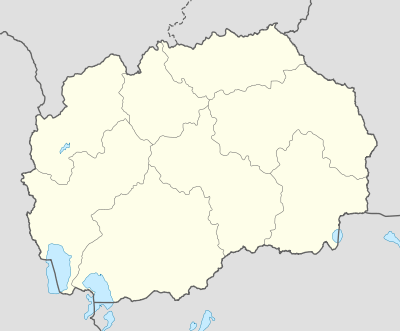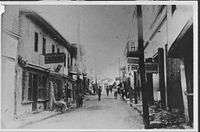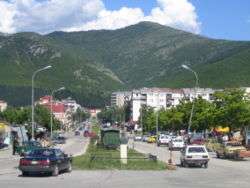Kičevo
| Kičevo Кичево | |
|---|---|
| Town | |
|
Kičevo | |
 Kičevo Location within Macedonia | |
| Coordinates: 41°31′04″N 20°57′56″E / 41.51778°N 20.96556°ECoordinates: 41°31′04″N 20°57′56″E / 41.51778°N 20.96556°E | |
| Country |
|
| Municipality | Kičevo Municipality |
| Government | |
| • Mayor | Fatmir Dehari (DUI) |
| Area | |
| • Total | 814.3 km2 (314.4 sq mi) |
| Population (2002) | |
| • Total | 27,076 |
| Time zone | CET (UTC+1) |
| • Summer (DST) | CEST (UTC+2) |
| Postal code | 6250 |
| Area code(s) | +389 |
| Car plates | KI |
| Climate | Cfb |
Kičevo (Macedonian: Кичево [ˈkitʃɛvɔ]; Albanian: Kërçovë/Kërçova) is a city in the western part of the Republic of Macedonia, located in a valley in the south-eastern slopes of Mount Bistra, between the cities of Ohrid and Gostivar. The capital Skopje is 112 km away. The city of Kičevo is the seat of Kičevo Municipality.
Population
The municipality of Kičevo has 56,734 inhabitants, and the city 27,076. The largest ethnic group in the city of Kičevo is the Macedonians who constitute for 15,031 people (55.5%), followed by the Albanians with 7,641 people (28.2%), the Turks with about 2,406 (8.9%) and Roma with 4.9%.[1]
Orthodox Christians made up 15,139 (55.9%) of the city's population according to the 2002 census, while Muslims were the second-largest religious group in the city, numbering 11,759 (43.4%).
The most common native languages are Macedonian (62.5%), Albanian (28.2%), Turkish (8.0%) and Romani 0.4%.
| Ethnic group |
census 1948 | census 1953 | census 1961 | census 1971 | census 1981 | census 1994 | census 2002 | |||||||
|---|---|---|---|---|---|---|---|---|---|---|---|---|---|---|
| Number | % | Number | % | Number | % | Number | % | Number | % | Number | % | Number | % | |
| Macedonians | .. | .. | 3,747 | 39.2 | 6,809 | 66.0 | 9,900 | 64.3 | 13,236 | 58.9 | 15,255 | 60.7 | 15,031 | 55.5 |
| Albanians | .. | .. | 232 | 2.4 | 681 | 6.6 | 2,284 | 14.9 | 4,516 | 20.1 | 5,902 | 23.5 | 7,641 | 28.2 |
| Turks | .. | .. | 4,749 | 49.7 | 2,079 | 20.2 | 2,041 | 13.3 | 2,175 | 9.7 | 2,175 | 8.7 | 2,406 | 8.9 |
| Romani | .. | .. | 54 | 0.6 | 0 | 0.0 | 17 | 0.1 | 304 | 1.3 | 1,235 | 4.9 | 1,329 | 4.9 |
| Serbs | .. | .. | 484 | 5.1 | 394 | 3.8 | 305 | 2.0 | 203 | 0.9 | 96 | 0.4 | 82 | 0.3 |
| Vlachs | .. | .. | 4 | 0.1 | 0 | 0.0 | 0 | 0.0 | 5 | 0.0 | 15 | 0.1 | 75 | 0.3 |
| Bosniaks | .. | .. | 0 | 0.0 | 0 | 0.0 | 0 | 0.0 | 0 | 0.0 | 0 | 0.0 | 7 | 0.0 |
| Others | .. | .. | 297 | 3.1 | 394 | 3.5 | 846 | 5.5 | 2,040 | 9.1 | 451 | 1.8 | 496 | 1.8 |
| Total | 7,280 | 9,567 | 10,324 | 15,393 | 22,479 | 25,129 | 27,076 | |||||||
Name
The name of the city in Macedonian and other South Slavic languages is Kičevo (Кичево). Kičevo is first mentioned as Ouskanas (Ούσκανας) during the reign of Perseus of Macedon, during the Third Macedonian War (171-168 BC). It was known as Uskana among its Illyrian inhabitants.
The next written record of the town did not come until 1018, under the name of Kicavis, noted in one of the documents of the Byzantine emperor Basil II.[3] Under the rule of Prince Marko it was known as Katin Grad, because Marko's sister was named Katina.
It is presumed that the present name of the town originates from the name of this settlement populated by the Slavic Brsjaci tribe.
History

Kičevo was noted in one of the documents of the Byzantine emperor Basil II in 1018, and also mentioned by the Ohrid archbishop Theophilact in the 11th century.
.jpg)
When the region was conquered by the Ottoman Empire, Kičevo was turned into the military and administrative center of the region. Notable monument of that period is a clock tower built in the foothills of the nearby hill called Kichevsko Kale.
In the late 19th and early 20th century, Kičevo was part of the Manastir Vilayet of the Ottoman Empire.
The activities of the Internal Macedonian Revolutionary Organization (IMRO) in the region of Kičevo were initiated by the priest Josif from the monastery of Bogorodica Prečista near the city, supported by many teachers from the neighbouring villages. On August 2, 1903, the Christian citizens of Kičevo participated in the Ilinden Uprising, led by Arso Vojvoda and Yordan Piperkata.
In 1913 Kičevo and the whole region were incorporated in the Kingdom of Serbia, and as such, became part of the Kingdom of Serbs, Croats and Slovenes in 1918. From 1929 to 1941, Kičevo was part of the Vardar Banovina of the Kingdom of Yugoslavia.
During World War II, Kičevo was occupied by forces from Fascist Italy. On September 9, 1943 Macedonian and Albanian partisan units disarmed the Italian garrison and took control of the city.[4] Thus, Kičevo became the first liberated city during the World War II in Macedonia.
Monuments

Monastery of St. Bogorodica Prečista (Monastery of Immaculate Mother of God) is a significant monastery near Kičevo. Dedicated to the Virgin Mary, Mother of God, the feast day of this monastery is "Mala Bogorodica", (Birthday of the Virgin Mary on the 21st of September). The monastery, dedicated to the Annunciation and lodgings for devout female monks, represents a medieval monastery that was known under the name Krninski monastery in the past.
Another important monument is the monastery of St. George located in the vicinity of Kičevo.
There are also many important mosques from the Ottoman Empire's times of rule and from the Islamic Albanian population.
Notable people
- Ardian Cuculi, footballer
- Besart Ibraimi, footballer
- Florian Kadriu, footballer
- Omer Kaleshi, painter
- Yoakim Karchovski, priest
- Vlatko Lozanoski, singer
- Vesna Milošević, former handballer
- Vlado Taneski, journalist and criminal
References
- ↑ Macedonian census, language and religion
- ↑ Censuses of population 1948 - 2002
- ↑ Dalibor Brozović, Hrvatska enciklopedija, 1999, s.v. "Kičevo".
- ↑ Pearson, Owen (2006). Albania in Occupation and War: From Fascism to Communism 1940-1945. I.B.Tauris. p. 271. ISBN 1-84511-104-4.
External links
- Kičevo web site - mk
- Kičevo web site - sq
- Kičevo portal web
- Information on Kicevo as part of the "New Economic Geography" map of the European Stability Initiative

